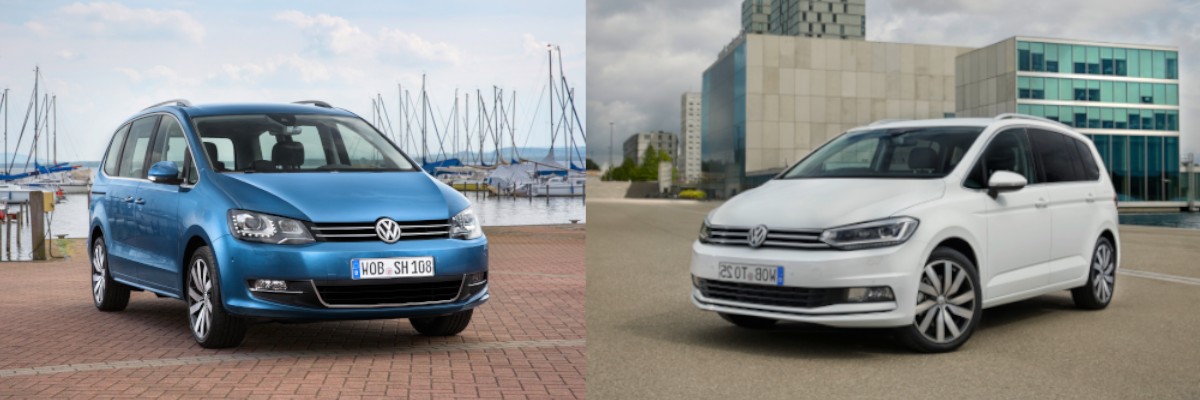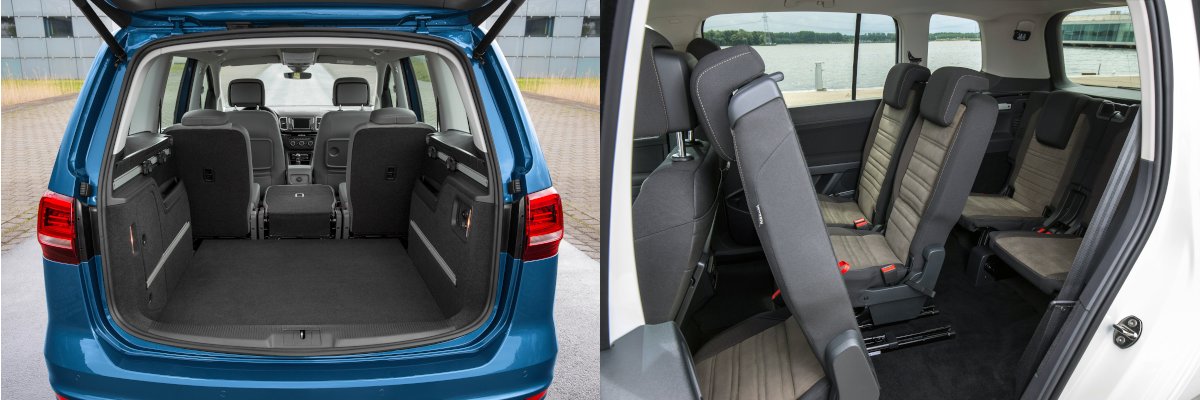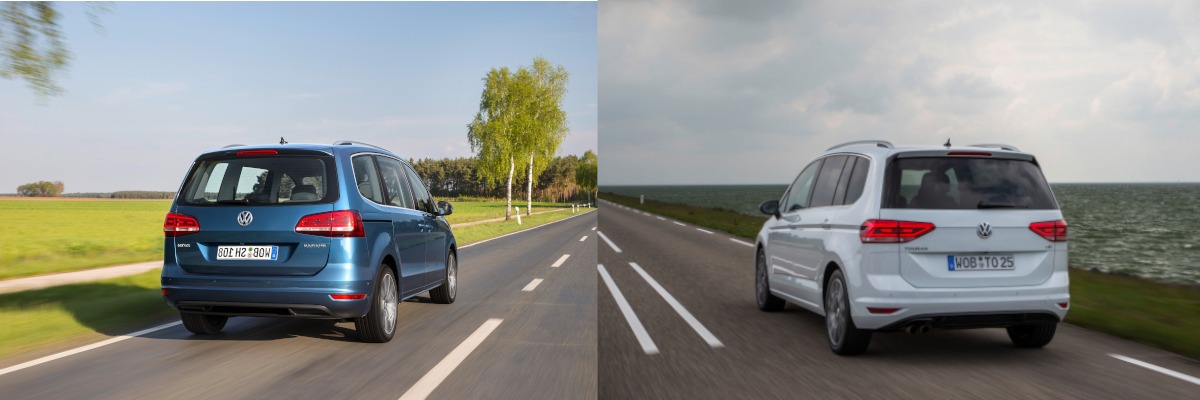If you’re after a practical car that still offers lots of comfort, the VW Sharan and VW Touran are well worth a look. But what are the differences between these two Volkswagen models, and which one’s going to suit you best?
The important thing to note is that the Sharan is the larger of the two. It’s 33cm longer, 7.5cm wider and 6cm taller than the Touran. That gives the latter a more aerodynamic look, but the Sharan puts the extra space to great use when it comes to the interior. You might also notice the positioning of the door handles on the Sharan. That’s because it has sliding doors, which is a real plus point.
Conclusion: The smaller, sleeker Touran has the edge when it comes to looks, but don’t forget about the Sharan’s sliding doors!
The Sharan’s extra space means it takes seven adults in greater comfort than the Touran, which could be very useful if you’re playing taxi to a handful of teenagers and all their gear. Each seat in the middle row slides forwards and backwards independently, while the outer two can be optioned as child booster seats. The infotainment system that comes as standard has a 6.5” colour touch screen, while there are plenty of cubby-holes and two large storage compartments in the roof.
Both models come with ergonomic features like multi-function steering wheels, and are highly flexible when it comes to the interior, allowing various seat combinations depending on what you need. The Sharan’s back seats offer more space, and it has a greater luggage capacity too. With the rear seats upright you get 300 litres, compared to 137 in the Touran. With the rear seats folded, you get a whopping 2,297 litres in the Sharan, 440 more than its sibling.
Conclusion: The Sharan takes this round with its more spacious interior, which includes both luggage space and leg room for the rear seats.
• Comes in a 1.4-litre petrol version which pumps out 150hp if you're a driver that prefers a petrol car.
• Will take you from 0-62mph in 8.9 seconds with its most powerful diesel engine, with the petrol version taking a second longer.
• Has very strong fuel consumption across the engine range, although the petrol motor naturally trails the diesels. The 115 and 150hp diesels are the most efficient engines, giving you a combined 56.5mpg with a manual gearbox.
• Offers engines that all meet the latest EURO 6 exhaust gas regulations, with diesel CO2 emissions starting at 130g/km and petrol at 150g/km.
• Is smaller in size which means it lends itself more favourably to a petrol engine, and there are two to choose from. There are 1.2-litre and 1.4-litre options available, with the more powerful unit’s 150hp giving you an extra 40hp over the alternative.
• Has three diesel options you can go for, with the entry-level a 1.6-litre TDI that offers 115hp. The top-spec 2.0-litre TDI is available on the SEL and R-Line models, and packs a punch with 190hp.
• Can get from 0-62mph in a diesel-powered 8.2 seconds, while the quickest petrol engine takes 8.9 seconds.
• Provides strong fuel efficiency, with the 150hp version of the 2.0-litre TDI SCR offering a nice blend of economy and torquey grunt, giving you a combined 60.1mpg.
• Like the Sharan, comes with the AdBlue® advanced emissions control system, which helps it achieve 126g/km with its cleanest petrol engine, and 113 with the diesels.
Conclusion: These VW engines are built to be reliable, although the Touran’s most powerful diesel engine provides the most exciting drive.
In numbers…
Two very similar cars on the face of it, but there are key differences. For relatively tall MPVs, both stick to the road beautifully when cornering, but the Touran offers a more dynamic ride and the improved styling to go with it. The Sharan has more space and comfier rear seats, plus those sliding doors which may steal your heart.
Size or slenderness?

The important thing to note is that the Sharan is the larger of the two. It’s 33cm longer, 7.5cm wider and 6cm taller than the Touran. That gives the latter a more aerodynamic look, but the Sharan puts the extra space to great use when it comes to the interior. You might also notice the positioning of the door handles on the Sharan. That’s because it has sliding doors, which is a real plus point.
Conclusion: The smaller, sleeker Touran has the edge when it comes to looks, but don’t forget about the Sharan’s sliding doors!
Practical vs practical

The Sharan’s extra space means it takes seven adults in greater comfort than the Touran, which could be very useful if you’re playing taxi to a handful of teenagers and all their gear. Each seat in the middle row slides forwards and backwards independently, while the outer two can be optioned as child booster seats. The infotainment system that comes as standard has a 6.5” colour touch screen, while there are plenty of cubby-holes and two large storage compartments in the roof.
Both models come with ergonomic features like multi-function steering wheels, and are highly flexible when it comes to the interior, allowing various seat combinations depending on what you need. The Sharan’s back seats offer more space, and it has a greater luggage capacity too. With the rear seats upright you get 300 litres, compared to 137 in the Touran. With the rear seats folded, you get a whopping 2,297 litres in the Sharan, 440 more than its sibling.
Conclusion: The Sharan takes this round with its more spacious interior, which includes both luggage space and leg room for the rear seats.
Economical engines

The Sharan...
• Is best suited to diesel engines because of its weight. There are three 2.0-litre TDI SCR 4-cylinder diesel options to choose between, with the horsepower ranging from 115 to 184hp.• Comes in a 1.4-litre petrol version which pumps out 150hp if you're a driver that prefers a petrol car.
• Will take you from 0-62mph in 8.9 seconds with its most powerful diesel engine, with the petrol version taking a second longer.
• Has very strong fuel consumption across the engine range, although the petrol motor naturally trails the diesels. The 115 and 150hp diesels are the most efficient engines, giving you a combined 56.5mpg with a manual gearbox.
• Offers engines that all meet the latest EURO 6 exhaust gas regulations, with diesel CO2 emissions starting at 130g/km and petrol at 150g/km.
Whereas the Touran...
• Is smaller in size which means it lends itself more favourably to a petrol engine, and there are two to choose from. There are 1.2-litre and 1.4-litre options available, with the more powerful unit’s 150hp giving you an extra 40hp over the alternative.
• Has three diesel options you can go for, with the entry-level a 1.6-litre TDI that offers 115hp. The top-spec 2.0-litre TDI is available on the SEL and R-Line models, and packs a punch with 190hp.
• Can get from 0-62mph in a diesel-powered 8.2 seconds, while the quickest petrol engine takes 8.9 seconds.
• Provides strong fuel efficiency, with the 150hp version of the 2.0-litre TDI SCR offering a nice blend of economy and torquey grunt, giving you a combined 60.1mpg.
• Like the Sharan, comes with the AdBlue® advanced emissions control system, which helps it achieve 126g/km with its cleanest petrol engine, and 113 with the diesels.
Conclusion: These VW engines are built to be reliable, although the Touran’s most powerful diesel engine provides the most exciting drive.
In numbers…
|
|
VW Sharan |
VW Touran |
||
|
Min |
Max |
Min |
Max |
|
|
Power (HP) |
115 |
184 |
110 |
190 |
|
Fuel (comb MPG) |
42.2 |
56.5 |
49.6 |
65.7 |
|
Emissions (CO2, g/km) |
130 |
156 |
113 |
133 |
|
Top Speed (mph) |
114 |
136 |
117 |
130 |
|
0 – 62mph in…. (seconds) |
9.9 |
9.3 |
11.3 |
8.2 |
|
Price |
£29,140 |
£38,625 |
£23,570 |
£29,135 |
Two very similar cars on the face of it, but there are key differences. For relatively tall MPVs, both stick to the road beautifully when cornering, but the Touran offers a more dynamic ride and the improved styling to go with it. The Sharan has more space and comfier rear seats, plus those sliding doors which may steal your heart.
The bottom line is, both of these cars are great buys and whichever model you decide to go for, you can't really go too far wrong.
View our latest Volkswagen offers
If you’d like to test-drive some of the latest VW Sharan and VW Touran models, head to your local Group 1 Volkswagen, or contact us online if you'd like any more information.
